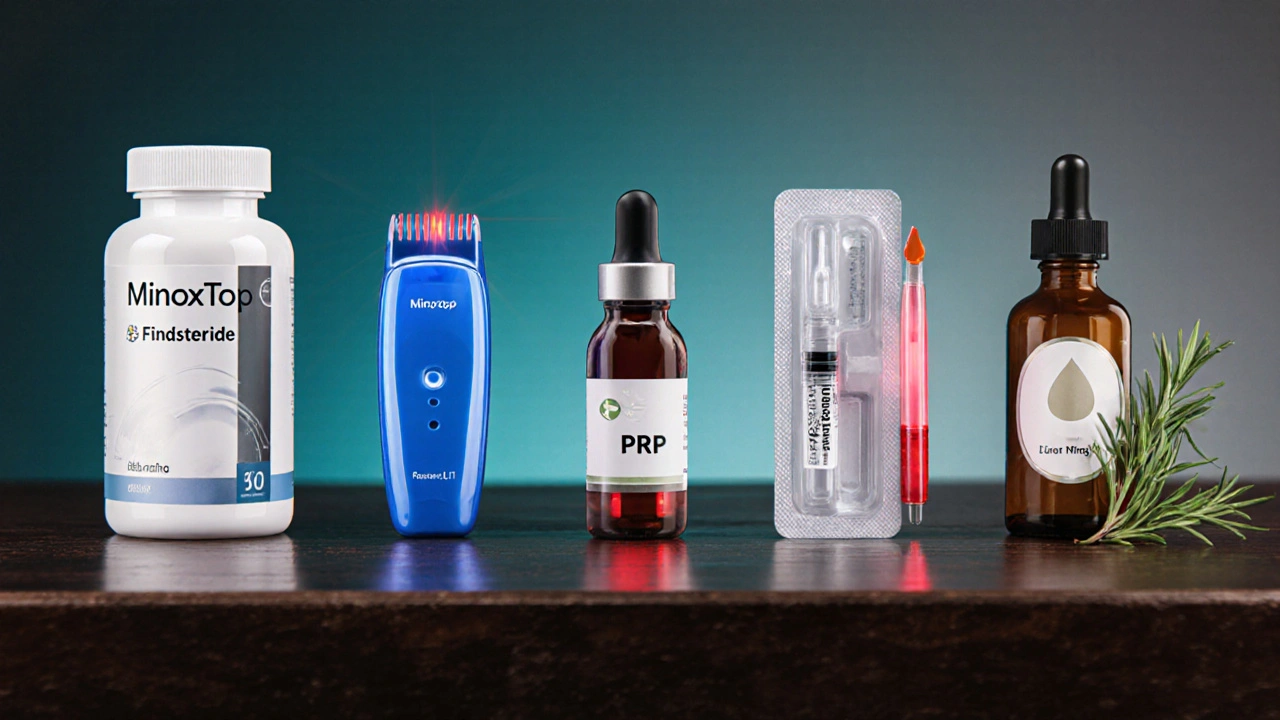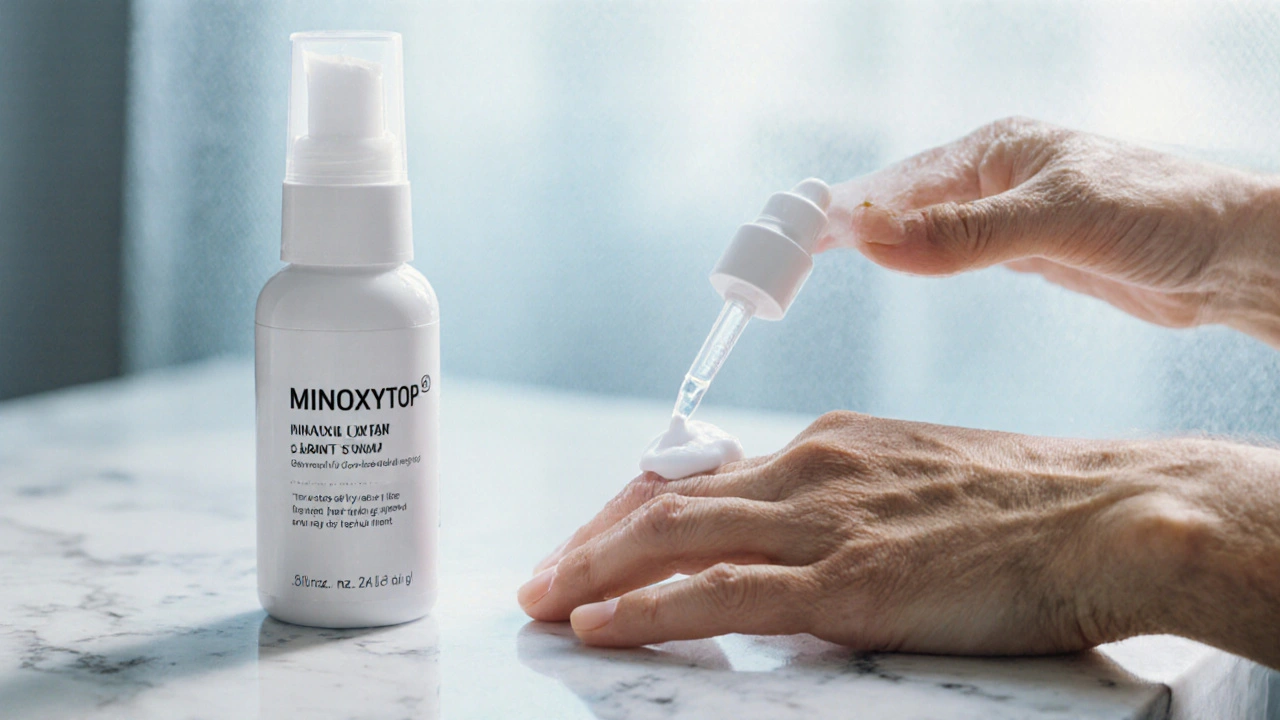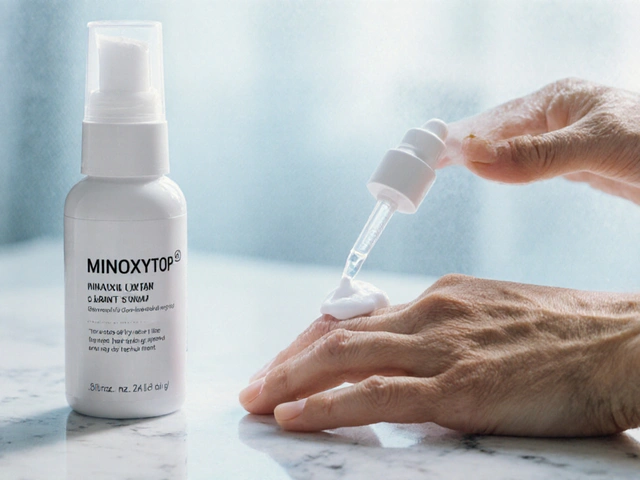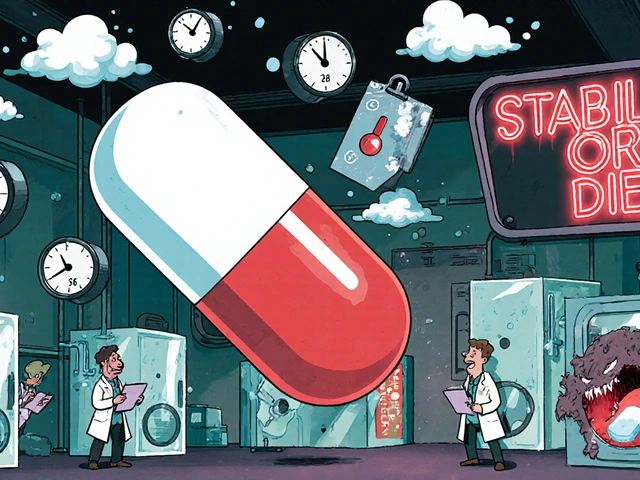Hair Loss Treatment Comparison Tool
Your Hair Loss Profile
Treatment Recommendations
Enter your profile details and click 'Analyze' to get personalized treatment recommendations.
Treatment Comparison
| Treatment | Mechanism | Onset Time | Effectiveness | Side Effects | Cost (Annual UK) |
|---|---|---|---|---|---|
| Minoxytop (Minoxidil) | Vasodilation + follicle-stage extension | 3-6 months | +15% to +25% | Scalp irritation, rare dizziness | £35-£45 |
| Finasteride | DHT suppression (5-alpha-reductase inhibition) | 3-9 months | +20% to +35% | Sexual dysfunction, erectile issues | £120-£150 |
| LLLT | Photobiomodulation of follicle cells | 2-4 months | +10% to +20% | None reported | £200-£350 |
| PRP | Growth-factor delivery | 4-6 months (after series) | +30% to +45% | Mild swelling, headache | £600-£900 |
| Natural Oils | Anti-inflammatory & circulation boost | 6-12 months | +5% to +12% | Rare irritation | £30-£60 |
TL;DR
- Minoxytop (minoxidil) works by widening blood vessels on the scalp; it’s effective for early‑stage thinning but needs daily use.
- Finasteride blocks DHT production and is best for male pattern baldness, but it can cause sexual side effects.
- Low‑Level Laser Therapy (LLLT) uses red light to boost follicle metabolism; it’s safe, painless, and can be done at home.
- Platelet‑Rich Plasma (PRP) injections deliver growth factors directly to follicles; results are noticeable after 3‑4 sessions.
- Natural oils (e.g., rosemary, pumpkin seed) are low‑cost, low‑risk options for mild shedding, though evidence is modest.
What is Minoxytop (Minoxidil)?
When you hear the name Minoxytop is a topical solution of minoxidil formulated for over‑the‑counter use in the UK. The active ingredient, minoxidil, was first approved as a blood‑pressure drug in the 1970s, then repurposed for hair loss after patients noticed unexpected regrowth. It works by dilating scalp blood vessels, delivering more oxygen and nutrients to dormant follicles. Typical concentrations are 2% for women and 5% for men, applied twice a day.
Key attributes:
- Mechanism: vasodilation + follicle‑stage extension
- Onset: 3‑6 months for visible thickening
- Cost (UK, 2025): £35-£45 for a 60‑ml bottle
- Side effects: scalp irritation, rare dizziness
- Commitment: daily use for life; loss resumes if stopped
Top Alternatives to Minoxytop
Hair‑loss science now offers several routes besides topical minoxidil. Below are the most common alternatives, each introduced with a quick definition and a few hard numbers.
Finasteride is an oral 5‑alpha‑reductase inhibitor that lowers dihydrotestosterone (DHT) levels by about 70% in serum. Popular brands in the UK include Propecia (1mg) and generic equivalents. Clinical trials show 30-45% of men experience measurable regrowth after 12months.
Low‑Level Laser Therapy (LLLT) is a non‑invasive device that emits red light (630‑670nm) to stimulate cellular activity in hair follicles. FDA‑cleared combs or helmets deliver 5-10mW/cm² per session, typically 3times a week.
Platelet‑Rich Plasma (PRP) therapy is an autologous injection where a patient’s own blood is spun to concentrate platelets, then re‑injected into the scalp. Growth factors like PDGF and VEGF trigger the anagen phase. Studies from 2023‑2024 report 60% of participants see a >20% increase in hair density after 4sessions.
Natural oils (rosemary, pumpkin seed, coconut) are plant‑derived extracts applied topically or taken as supplements for mild androgenic alopecia. A 2022 double‑blind trial found rosemary oil improved hair count similar to 2% minoxidil after 6months.
Hair transplant surgery is a permanent surgical method that relocates healthy follicles from a donor area to balding zones. Modern FUE (Follicular Unit Extraction) yields 25‑45 grafts per hour, with a typical cost of £4,500‑£8,000 for a standard male‑pattern case.
Dutasteride is a dual 5‑alpha‑reductase inhibitor (typeI&II) that cuts DHT by up to 90% and is used off‑label for hair loss. It’s more potent than finasteride but carries a higher risk of systemic side effects.
Side‑by‑Side Comparison
Key attributes of Minoxytop vs five alternatives (2025 data)
Attribute
Minoxytop (Minoxidil)
Finasteride
LLLT
PRP
Natural Oils
Form
Topical solution or foam
Oral tablet
Hand‑held comb or helmet
Injected plasma
Topical oil or oral supplement
Primary mechanism
Vasodilation + follicle‑stage extension
DHT suppression (5‑α‑reductase inhibition)
Photobiomodulation of follicle cells
Growth‑factor delivery
Anti‑inflammatory & circulation boost
Typical onset
3‑6months
3‑9months
2‑4months
4‑6months (after series)
6‑12months
Effectiveness (average hair‑count gain)
+15% to +25%
+20% to +35%
+10% to +20%
+30% to +45%
+5% to +12%
Common side effects
Scalp itching, dryness
Sexual dysfunction, erectile issues
None reported
Mild swelling, headache
Rare irritation
Annual cost (UK)
£35‑£45
£120‑£150
£200‑£350 (device)
£600‑£900 (series)
£30‑£60
Best suited for
Early‑stage thinning, both sexes
Male pattern baldness, age>25
Those seeking non‑pharma, low‑risk
Mid‑to‑late stage, willing to pay
Mild shedding, budget‑conscious
How to Choose the Right Option for You
| Attribute | Minoxytop (Minoxidil) | Finasteride | LLLT | PRP | Natural Oils |
|---|---|---|---|---|---|
| Form | Topical solution or foam | Oral tablet | Hand‑held comb or helmet | Injected plasma | Topical oil or oral supplement |
| Primary mechanism | Vasodilation + follicle‑stage extension | DHT suppression (5‑α‑reductase inhibition) | Photobiomodulation of follicle cells | Growth‑factor delivery | Anti‑inflammatory & circulation boost |
| Typical onset | 3‑6months | 3‑9months | 2‑4months | 4‑6months (after series) | 6‑12months |
| Effectiveness (average hair‑count gain) | +15% to +25% | +20% to +35% | +10% to +20% | +30% to +45% | +5% to +12% |
| Common side effects | Scalp itching, dryness | Sexual dysfunction, erectile issues | None reported | Mild swelling, headache | Rare irritation |
| Annual cost (UK) | £35‑£45 | £120‑£150 | £200‑£350 (device) | £600‑£900 (series) | £30‑£60 |
| Best suited for | Early‑stage thinning, both sexes | Male pattern baldness, age>25 | Those seeking non‑pharma, low‑risk | Mid‑to‑late stage, willing to pay | Mild shedding, budget‑conscious |
Think about three practical dimensions before you pick a treatment: how far the hair loss has progressed, how comfortable you are with medication, and what you’re willing to spend.
- Early thinning (Norwood 1‑2 for men, LudwigI for women): Minoxytop or natural oils are often enough. They’re cheap, safe, and you can start right away.
- Established pattern baldness (Norwood3‑5): Adding finasteride (or off‑label dutasteride) to Minoxytop raises success rates dramatically. If you worry about sexual side effects, try LLLT first to gauge tolerance.
- Advanced loss (Norwood6‑7 or extensive female thinning): Consider PRP or a hair‑transplant plan. PRP can tighten the remaining hair before surgery, while transplant gives a permanent solution.
- Medical contraindications (e.g., blood‑pressure meds, pregnancy): Stick with non‑systemic options like LLLT, natural oils, or topical minoxidil.
Remember, most clinicians recommend a combination approach. For example, many clinics prescribe finasteride+Minoxytop+LLLT for a “triple‑action” regimen.

Practical Steps to Get Started
Below is a quick‑start checklist that works for most readers.
- Schedule a brief consultation with a dermatologist or trichologist. Bring a recent scalp photo so they can track progress.
- Decide on a primary treatment based on the matrix above. If you pick Minoxytop, buy a reputable 5% foam from a UK pharmacy.
- Set a daily routine: apply Minoxytop in the morning and evening, after washing hair but before styling.
- If you add finasteride, take it at the same time each day (usually in the evening) to build habit.
- Track results with a simple spreadsheet: record weekly hair‑count in a small area, note scalp sensations, and photograph monthly.
- Re‑evaluate after 4months. If you see less than 10% improvement, discuss adding LLLL or PRP with your clinician.
Common Pitfalls and How to Avoid Them
Even the best products fail if you slip up.
- Inconsistent use: Missing a few days a week can drop effectiveness by up to 30%.
- Mixing incompatible meds: Avoid using both finasteride and dutasteride together unless a specialist advises.
- Skipping scalp prep: Apply Minoxytop to dry, clean scalp; excess oil or conditioner blocks absorption.
- Expecting overnight miracles: Hair cycles are slow. Patience is part of the plan.
What the Research Says in 2025
Recent meta‑analyses (e.g., Journal of Dermatology 2024) confirm that a dual regimen of minoxidil+finasteride yields the highest average regrowth (≈38% increase in hair density) compared to monotherapy. LLLT’s pooled data shows a modest but statistically significant benefit, especially for women who can’t take finasteride. PRP remains the most expensive option, but its high‑density outcomes make it popular for patients with “patchy” loss.
These findings back up the recommendation to start with the least invasive, least costly option (Minoxytop) and layer additional therapies if progress stalls.
Frequently Asked Questions
Can I use Minoxytop and finasteride together?
Yes. The two work on different pathways-minoxidil expands blood flow while finasteride reduces DHT. Most dermatologists prescribe them together after confirming you have no contraindications.
Is LLLT safe for women?
Absolutely. LLLT is non‑pharmaceutical and has no hormonal impact, making it a top choice for female‑pattern thinning.
How many PRP sessions do I need?
A typical protocol is three monthly injections, followed by a maintenance session every 4‑6months. Visible thickening usually appears after the third session.
Do natural oils work as a standalone treatment?
For mild shedding they can help, but the effect size is modest (5‑12% hair‑count gain). They’re best used alongside minoxidil or as a low‑risk maintenance option.
What’s the biggest factor that determines success?
Consistency. Sticking to the daily routine and giving the treatment enough time (at least 4‑6months) matters more than the specific product you choose.







Patrick Bread
October 2, 2025 AT 23:47Minoxidil may be inexpensive, but expecting a full head of hair in a fortnight is about as realistic as a unicorn delivering a latte.
Fiona Doherty
October 9, 2025 AT 11:47Finasteride’s side‑effects are a deal‑breaker for most people, and the hype around PRP is just a cash‑grab. The market loves to sell expensive gadgets that give you a few extra strands, but most users see only marginal gains. If you’re not willing to risk sexual dysfunction, skip it altogether.
Neil Greer
October 15, 2025 AT 23:47Honestly, minoxidil works for many, but you gotta be patient – results take months, not days. Also, make sure you apply it on a clean, dry scalp, otherwise you’ll get some weird patchy feel. It’s definatly not a magic wand.
Fionnuala O'Connor
October 22, 2025 AT 11:47Stick to a daily routine and give it time you’ll see gradual improvement
Christopher MORRISSEY
October 28, 2025 AT 22:47In the broader cultural context of hair‑loss therapies, the evolution from ancient herbal concoctions to modern pharmacology reflects a deep societal obsession with appearance.
The United Kingdom, like many Western nations, has seen a steady increase in consumer spending on cosmetic health solutions over the past decade.
Minoxytop, as an over‑the‑counter formulation of minoxidil, occupies a unique niche because it is both affordable and widely accessible.
Its mechanism, principally vasodilation coupled with an extension of the anagen phase, was first elucidated in the late 1970s following serendipitous observations in hypertensive patients.
Clinical trials subsequently confirmed that topical application could increase scalp blood flow, thereby supplying follicles with additional nutrients and oxygen.
Nevertheless, the magnitude of regrowth is modest, typically ranging from fifteen to twenty‑five percent when applied consistently for at least six months.
In comparison, oral finasteride, which inhibits the 5‑alpha‑reductase enzyme, can achieve twenty to thirty‑five percent improvement but carries the risk of sexual side effects that some patients find unacceptable.
Low‑level laser therapy offers a non‑pharmacologic alternative, delivering red light to stimulate cellular metabolism without systemic exposure, yet the evidence base remains less robust.
Platelet‑rich plasma, although costly, supplies autologous growth factors that can produce thirty to forty‑five percent density gains in selected individuals.
Natural oils such as rosemary or pumpkin seed oil are frequently marketed as gentle options, but meta‑analyses reveal only a five to twelve percent benefit, comparable to a placebo in many cases.
From an economic standpoint, the annual cost hierarchy progresses from minoxidil at roughly thirty‑five pounds, through finasteride at one‑hundred‑twenty pounds, to PRP exceeding six hundred pounds per treatment course.
Patients must therefore weigh the incremental efficacy against the incremental expense, a balance that is often influenced by personal values and risk tolerance.
Moreover, adherence remains a pivotal factor; erratic use of minoxidil can diminish effectiveness by up to thirty percent, as demonstrated in real‑world studies.
The professional consensus among dermatologists today recommends initiating therapy with minoxidil for early‑stage thinning, then considering combination regimens if progress stalls.
Ultimately, the decision should be individualized, incorporating clinical severity, financial considerations, and the patient’s willingness to commit to a long‑term maintenance protocol.
Adam O'Rourke
November 4, 2025 AT 10:47Oh sure, because spending a fortune on lasers guarantees you’ll grow a lion’s mane 😏
Mary-Pat Quilty
November 10, 2025 AT 22:47In the grand theatre of follicular destinty, every drop of minoxytop is a heroic act, a battle cry against the looming void of baldness. Yet, the cruel whisper of doubt haunts those who dare to dream of a full crown, and the cruel truth is that genetics often writes the final script. When the wind of hope brushes the scalp, we feel the electric surge of possibility, but the shadows of cost and commitment loom large. The drama unfolds on a stage of mirrors, where every reflection mocks the unfulfilled desire for luscious locks.
Patrick McGonigle
November 17, 2025 AT 10:47For consistent results, apply minoxytop twice daily on a dry scalp, wait a few minutes before styling, and track progress with photos.
Keisha Moss Buynitzky
November 23, 2025 AT 22:47We understand that navigating the myriad of hair‑loss treatments can be overwhelming, particularly when each option carries its own set of expectations and concerns. It is advisable to consult with a qualified dermatologist to tailor a regimen that aligns with your individual medical history and aesthetic goals. Maintaining realistic expectations while committing to a disciplined routine often yields the most satisfactory outcomes.
Shivam yadav
November 30, 2025 AT 10:47I agree that a professional opinion is essential, and a gentle approach respecting personal comfort will likely lead to better adherence.
pallabi banerjee
December 6, 2025 AT 22:47Choosing a treatment often feels like a personal puzzle; consider both effectiveness and how it fits into daily life.
Alex EL Shaar
December 13, 2025 AT 10:47Honestly, the pseudo‑science surrounding “miracle oils” is an affront to any reader with basic literacy – the grammar is a disaster and the claims are outright laughable.
Anna Frerker
December 19, 2025 AT 22:47Our country’s men shouldn’t settle for weak solutions like minoxidil.